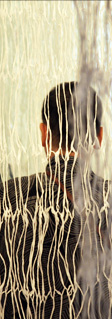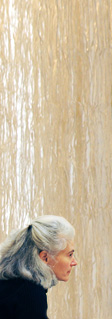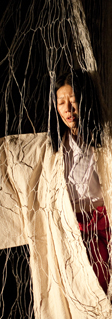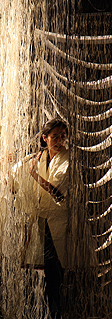| |
 |
|
| |
Kyoko Ibe
The development of papermaking in Japan owes a lot to the country’s geological conditions, climate, and the religious belief. Among daily necessities, paper has played an important role, providing even clothing and material for dwelling. Furthermore, paper has been used in rituals, ceremonies and festivals throughout Japanese history. The ancient Japanese believed that divine spirits were present in paper. They named paper “kami,” which is the same pronunciation as the word for gods and deities in Japan.
The oldest recycled paper is the backing of a painting in our national treasure house that was built in the 9 Century. It is natural to think that people recycled paper soon after they started making it and recycling was a part of paper production and consumption. A very special case was recorded in the 12 century, after the emperor died, his wife Fujiwara Tamiko recycled all the poems and letters she received from him and wrote a sutra on the recycled paper to wish peace in his soul. She then sent this sutra to his family and friends. While this is a special case, Japanese culture generally treats recycled paper as being more precious than new. The Japanese believe there is authentic beauty from something old. Ideas of transforming existing material to create new life as a means to continue the cultural tradition are highly valued.
Recycled gray tone paper was often used in the tearoom as the wall covering and for the sliding doors. I would like to mention the difference of the meaning of recycling at that time and now. We speak about recycling from eco or functional point of view. They found more positive deeper meaning and appreciated the beauty, which we could only get by aging. I think we have to learn from their philosophy to find the way to survive and to make our life in this limited, precious, fragile world.
About ten years ago, I purchased a book from the early 19 Century by chance and added it to my collection. The book was from a small northern village, no longer on modern maps. Inside there were records about the people in the village, with their name and occupation, rank of their farm, tax records, receipts, their contribution to the local temple and much more. All the text was hand written by sumi ink and calligraphy no longer in use; so there is no way to identify exact meaning of each piece of writing.
The paper itself and the writing evoke the spirit of the people from two hundred years ago and I can sense them slowly breathing in front of my eyes. I see a reflection of human life and spirit from nature in the kozo paper, which is very thin, translucent and delicate, yet it is durable and keeps its life for more than a thousand years. The antique book from two hundred years ago is proof of the invisible spirit from a past life that quietly breathes inside of the handmade paper and it opened my eyes to an almost forgotten beauty.
I disassembled and tore up the pages from the book into small pieces, made two groups, selected out the unwritten parts and put in them into the beater to get white kozo pulp. I did the same to the other written group and got gray recycled kozo. The mixture of fiber and water of this two hundred year old kozo pulp was completely different from a new liquid kozo fiber. The old one was so smooth and delicate compared to the rough new young kozo fiber. I poured the pulp on the screen mixed it with mica and with the planned calligraphic images and then poured on top the new kozo pulp. When I turned around and took off the screen, I was astonished that the difference of the age was so visible. But the harmony of old and new makes perfect new beauty. The process reminded me of the human life cycle- reincarnation as a part of the teaching of Buddha.
|
|
|
 |
|
| |
Elise Thoron
Recycling, making new of the old, and, in Japanese aesthetics, making the “new” richer because of the “old,” is a crucial for sustaining physical resources, and, as I am learning, the spirit. Paper (kami) moves fluidly between these two worlds in Japanese culture, and as such is a very interesting and privileged material. It is visible in Kyoko Ibe’s beautiful art work and invisible as the surface on which people write their daily lives: the screens, the scrolls, the paper tucked in the kimono, folded and tied onto trees and shrines. Kami – paper is also the name for the Gods.
Trying to understand the visceral power washi (hand made paper) has in Japanese life, it feels like one of grounding and purifying, of making light and shadow present, of being a texture for touching the invisible - ideas, spirits, dreams. It’s a way of regulating attention and light – of diffusing day and warming night - familiar in various forms of sliding doors and folding screens, but even placed over a florescent bulb washi adds grace to any room. It is ancient, much older than paper in the West. There are paper scrolls in Japan from 600 AD with government records, histories, poems, indigo paper with golden inked sutras; while in the West people were writing on sheepskin.
The process of making paper is an everyday alchemy, magical to behold, as a new sheet emerges wet and is peeled of the screen. It is grounded in an ancient craft that one can learn; to be expert takes knowledge, practice, and skill, but even I could produce a piece of paper under the instruction of my teachers. It is a beautiful craft, the tools: wooden mallet, basins, boards, brushes, and the dark green leaves that polish the final surface, in harmony with the material itself. To sleep in a room with paper walls, next to a screen, amid Kyoko’s work recycling 100 year old documents is to feel a deep peace and comfort.
Tied to nature, to seasons, to trees and shrines where it waves in the wind, washi is part gawa (river) and yama (mountain), where the kozo and gampi shrubs grow and the water that makes paper flows. (“Yama” or “gawa” are so frequent in the Japanese language, every place name seems to have a river or mountain in it). Paper is of the land and human labor, a symbiotic relationship that is typical of what I saw in rural Japan. When I walked on an ancient pilgrimage route, we felt the sway of these forces everyday, the steep climb up a yama, the descent to the rushing water of gawa, the thick cloud, forest, and bird calls in between. Paper holds these land forms in its fiber, and becomes a surface on which words and images abstracted from this landscape hang in temples and castles.
In Japan, craft and practice go back for so many generations there is a profoundly different attitude to handcrafted work and the place of tradition in daily life. In America there is a perpetual striving for the young and new, which while present in Japan, adapting latest trends to their own customs, the culture is also folded into the old. At some level, I feel that the intuition I had that paper was not only the material of our theater piece, but the subject as well, is a good one. The medium and message it carries are one, moving from past into the future
Kyoko Ibe’s art work drew me to washi paper and inspired this work in theater -- an increasingly rare and unique art form of presence -- people gathered in a room to have an experience, unmediated or processed by others. Washi asks you to be present for a few moments to touch the ephemera of daily life. It also invokes rhythms and rituals folding history quite naturally into a blank page. I am fortunate to find others compelled by Kyoko Ibe’s work and the medium itself to join us in this exploration.
|
|
|
 |
|
| |
Makiko Sakurai
Fujiwara Tamiko diary: April 8, 2011
Makiko Sakurai, the condition of her voice is bad from the dry country, Chicago U.S.A.
She calls Tamiko. Makiko plays the role of Tamiko.
Tamiko comes to respond to the U.S.A. They start talking to each other.
The news from Japan is really a tragedy - people taking refuge, serious about a nuclear power plant disaster at Fukushima. Sometimes Makiko felt not to go back to Japan.
There are lot of sorrows and anxiety.
Makiko plays Fujiwara Tamiko. But she played by herself.
One day Makiko asked Fujiwara Tamiko:"You desert your posterity? People know you and take over your culture. Japanese become extinct?""We, your ancestor, will think about it."
When the performance started Tamiko came to Maiko Sakurai. Tamiko always asked her, "Let's go back to Japan, back to Nara." Tamiko didn't like U.S.A.
"Even if there is a lot of radioactivity, I want to go back to Nara. You also come to Nara." Actually, Tamiko's family (Fujiwara) temple is Kofuji-temple and her family shrine is Kasuga-shrine in Nara. She wants to go back to her family more than to her husband.
When Makiko Sakurai played on the stage the last show in NYC, she didn't play anymore. Tamiko played "Washi Tales."
After the show, Makiko took Tamiko to the Metropolitan Museum in NYC. She saw a lot of interesting of works of art.
In the corner of European painting, portraits are aristocrats. Their expression and behavior are aristocratic like her and people around her.
She suddenly felt comfortable.
In the archeological corner in Middle East, she found some taste of her home place, Nara. She knows how people in the same time period lived their lives. She felt same taste in her life.
She stood with her eyes fastened on the deer's ornament and vessel in Persian times. Her tribe, Fujiwara, is also connected to deer. They hunted deer and worshipped deer. She finds very interesting the ancient Persians.
She found the statue of Buddha in ancient India. The pose is the same as the Goddess of Mercy at Chuguji-temple and Bodhisattva at Koryuji-temple. She understood Bodhisattva, in whom she has faith, come from India.
When she looked at the Chinese corner, the huge statue of Buddha greeted the Chinese American children who visit on a school excursion. The girl looked up at this statue.
Tamiko visited to Japanese corner. There are mystic and amazing statues of Dainichi-nyorai, esoteric Buddha and household, are waiting for her quietly.
Tamiko asked Dainichi-nyorai: "You don't go back to Japan?" Dainichi-nyorai answered: "No, I'm staying in U.S.A. forever.""Why do you live apart from Japan?"
"My part is to greet Japanese people here like you. People could go back to the home in their mind." Tamiko reflected. She just thinks herself. And she realizes that she could work for descendants anywhere in the present day.
Tamiko is brought back to life now.
|
|
|
 |
|
| |
Sonoko Soeda
I love Theatre/Play because it is NOT individual competition; it is a harmony that many people need to get together (not only performers but also the people behind the stage) and pool their own abilities as much as they can. Washi Tales plays a really good harmony, I am so happy that I can be one of the Washi sound.
Recycling: washi tales is since 2009.
We have built our story little by little, yes, step by step.
Washi Family (I call our company like this!) --- we are from different fields of expression/art. Washi, Musical instrument, Voice, Movement, Theatre, Traditional, Contemporary, West, East.
Once we have the time to make Washi Tales, we come together from all over the world. Having dense/rich time to create Washi world. Really intense time. When I'm here, I feel like…never stop, can go on and on and on forever…but, each of us needs to go back their own place once the stage curtain falls. We go home, and then plow up our own time/life, have fertile rain at our own fields, and gather "something." I don't miss my Washi Family, because I know we come back here again and work together again for Washi Tales. I love it. I really love to share what each of us gains new from our own place. Same faces, but it is not. It becomes a brand-new Washi Tales. We can make one, because we are different.
In the beginning of next spring, we are going to come together again,
I can't wait…!
Now, it's getting chilly in Tokyo…day by day. The sky is going to high and high, when I see my three-year-old daughter is reaching her little hands to the blue sky… I feel like… she may be able to touch the next/beyond of it.
I hope you also look up this clear blue sky…and touch…
See you again,
Sonoko Soeda
Autumn in Tokyo, 2015
|
|
|
 |
| |
Reginald Dwayne Betts
Paper, perhaps surprisingly, is a key part of the prison experience. Paper gets you in and sometimes gets you free. Chasing paper on the front is the catalyst to cuffs for many; making papers—that is, parole—is the hope of freedom for others. Inside, letters from family are lifelines, earning the slang moniker "kite" and there is an edge of exhilaration when a kite is slipped into a cell by a guard during mail call or under a cell door by another prisoner. For years after my release, I carried around a slip of paper in my wallet. A receipt for twenty-five dollars and seventy-one cent, the last of the money I’d earned working for 45 cent an hour in a Virginia prison. The experience is marked by paper. Transforming the paper into art complexifies the experience, makes it more than loss, more than the account for crimes and prison time that seem to stalk.
|
|
